Jean-Honoré Fragonard and the Abbé de Saint-Non in Italy
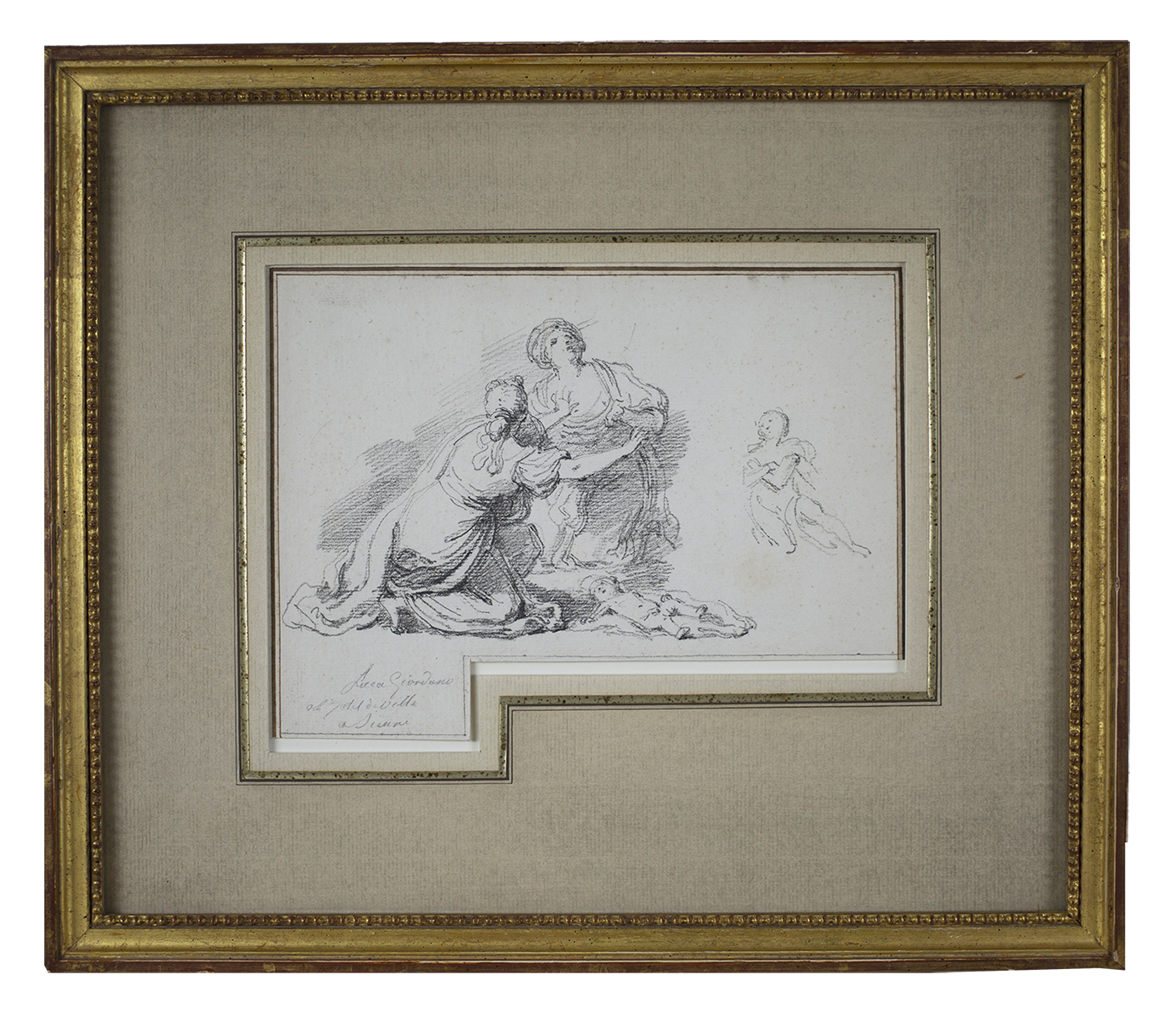
Jean-Honoré Fragonard
(Grasse, 1732 – Paris, 1806)
Details of Luca Giordano’s Judgment of Solomon and Domenico Beccafumi’s fresco in Siena’s Palazzo Pubblico.
Executed on April 16 or 17, 1761
Black chalk
125 mm (150 mm with inscription) x 202 mm – 4 15/16 (5 7/8 with inscription) x 7 15/16 in.
Annotation in pencil, lower left, by Abbé de Saint-Non: Luca Giordano à l’Hôtel de ville à Sienne
Provenance:
- Abbé de Saint-Non[1]: annotation in his hand lower left, 1761
- Possibly part of lot 179 of the anonymous sale (Chabot et de La Mure), December 17, 1787 (sold to Desmarais) [2].
- Paris, galerie Geoffrey Dodge & Cie, 1926
Exhibition:
- 68 dessins de Fragonard souvenirs de son voyage à Rome et à Florence, catalog d’une exposition, Paris, Geoffrey Dodge[3] & Cie, introduction by Charles Oulmont, 1926, p. 6, no. 18
Our black chalk drawing by Jean-Honoré Fragonard is a recent rediscovery of which we knew of no reproduction. It is mentioned only in a booklet published in 1926 on the occasion of an exhibition of 68 drawings by the artist, and has not been published since[4]. Although this document is not illustrated, we can nevertheless relate it to no. 18 in the list of works exhibited: Dessin, d’après Luca Giordano (HOTEL DE VILLE DE SIENNE)[5]. Indeed, our sheet, depicting two young women kneeling with a baby lying on the floor, takes up the central part of the Judgment of Solomon[6] painting(fig. 1) by Luca Giordano (Naples, 1634-1705), a work still in place above the door of the Consistory Hall in Siena’s Palazzo Pubblico(fig. 2).
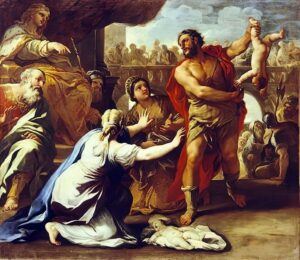
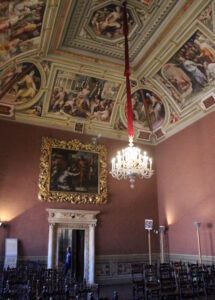
Born in Grasse in 1732, Jean-Honoré Fragonard arrived in Paris at the age of six, and from the age of thirteen trained with Jean-Siméon Chardin, then François Boucher. In 1752, he won the Prix de Rome and, after two years of teaching at the École royale des Élèves protégés, went to Rome as a boarder at the Académie de France. It was during this stay that he made the acquaintance of Jean Claude Richard de Saint-Non, the famous Abbé de Saint-Non[7], whom he had met in Tivoli, and who became his protector, offering to accompany him on his return journey to France.
During this trip, from April[8] to September 1761, “the Abbé de Saint-Non wanted Fragonard to work as he pleased, asking him to copy what he thought it would be interesting to keep as a souvenir: from Ronciglione to Nîmes, passing through Siena, Florence, Pisa, Venice, Padua, Vicenza, Verona, Mantua, Reggio, Modena, Bologna, Parma and Colorno, Piacenza, Genoa and Saint-Rémy de Provence. The artist made no fewer than three hundred copies after the most famous masters, as well as a number of illustrious sites. The trip was to last 5 months[9].
It was during a stopover in Siena that Fragonard produced our drawing. In his Journal de voyage, the Abbé de Saint-Non mentions a stopover in this Tuscan city on April 16 and 17, sharing his impressions and remarkable sights not to be missed, including, in particular, the Palazzo Pubblico: “… one must not forget either to see, in the main hall of the Hôtel de Ville, several paintings by different masters, and among others a Judgment of Solomon by Luca Giordano, which is of admirable color[10].”
We know of two other drawings by Fragonard(Detail of The Immaculate Conception after Carlo Maratta[11] in the British Museum and Detail of The Probatic Pool after Sebastiano Conca and Death of Saint Thomas of Villeneuve after Raffaelo Vanni[12] in the Norton Sumon Museum) made in Siena after works also mentioned in the writings[13] of Saint-Non.
During his stay in Italy, Fragonard copied more than fifteen works by the Neapolitan artist, first in Naples in 1760, and then on his return trip to France with the Abbé de Saint-Non. In particular, he produced eight drawings[14] based on the frescoes in Florence’s Palazzo Medici-Riccardi (two examples: fig. 3, Allegory of Temperance and Death of Adonis, London, British Museum inv. 1936,0509.30 and fig. 4 Jupiter and Three Nymphs, London, British Museum inv. 1936,0509.32). As Pierre Rosenberg points out: “There is no doubt that the inventive genius of the “fa presto” (the name given to Luca Giordano), the freedom of his workmanship and his taste for improvisation were of great importance to Fragonard. He had already admired it in Naples, and copied it in Venice, Padua, Vicenza and Genoa[15].


Fragonard chose to illustrate the central part of Luca Giordano’s composition, The Judgment of Solomon, whose subject is inspired by a story from the First Book of Kings (3, 16-28) in the Old Testament. Solomon, king of Israel, must judge a case in which two women are fighting over a newborn child, both claiming to be its mother. To settle the dispute, he orders one of his soldiers to cut the child in half and give half to each of them. In order to save her child’s life, the real mother is ready to give him up, spontaneously revealing her maternity.
On the right-hand side of our sheet, Fragonard has sketched a small silhouette that we propose to link to an angel figure painted by Domenico Beccafumi (Valdibiena, c. 1486 – Siena, 1551) on the ceiling[16] of the Consistory Hall in Siena’s Palazzo Pubblico (same location as Luca Giordano’s painting). Placed in a small spandrel(figs. 5 and 6), lower right, of the fresco of The Reconciliation between Marco Emilio Lepido e Fulvio Flacco for love of country, it could be, according to Mariana Jenkins, a personification of hope[17].
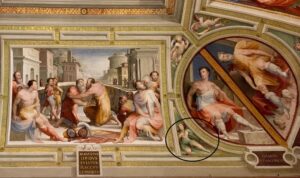
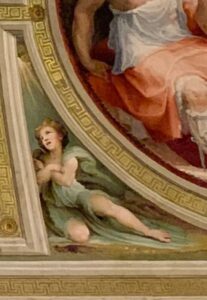
As Charles Oulmont points out in his introduction to the catalog of Fragonard’s 68 drawings: “A master’s copy after a master has (…) a double importance: firstly, it underlines better, or at any rate more strongly, the characteristics of each of the two painters, it brings out their particular genius, brings it into full view; secondly, this copy is not just a copy, something like a piece of schoolwork, but a creation. The copyist recreates in his own way, according to his own temperament, the canvas, the sculpture, the drawing, that he has before his eyes: he remains himself in front of another[18].” Most of Fragonard’s drawings after old masters are not slavish copies, but rather a subjective selection of motifs, groups of figures or details that have caught the artist’s imagination and are deemed interesting for future works[19].
Our drawing is a perfect example of the intelligent eye of this young artist who, during a brief visit to Siena’s Palazzo Pubblico, chose to juxtapose a detail from Luca Giordano’s painting above the door of the Consistory Hall with an allegory from a spandrel on Domenico Beccafumi’s painted ceiling. This comparison is no doubt not accidental. Fragonard chose to focus his attention on the two women kneeling beside the dead child. Moving away from the biblical subject, he concentrated his study on their attitude and gestures: the arms stretched forward of the first, seen from behind, and the raised head of the second. As if to emphasize his choice and its intrinsic message, the artist may have intentionally sketched the angel figure alongside this group to symbolize the hope shown by the true imploring mother, the one who stretches out her arms towards the usurper, signifying her renunciation of claiming the child alive in an attempt to save him.
[1] Most of Fragonard’s drawings, executed after the great masters between May 1760 and September 1761, were part of the Abbé de Saint-Non’s collection or passed through his “atelier”, as they were annotated in his hand. Cf. A. Ananoff, L’œuvre dessiné de Fragonard, catalog raisonné, 3 vols, 1968, Paris, vol. 1, p. 165.
[2] A lot of 440 drawings after the masters, sold to Desmarais: “N° 179. Une collection de quatre cent quarante dessins exécutés par M. Fragonard dans un de ses voyages d’Italie, tant à Rome qu’à Gênes, Naples, Venise, Bologne, Florence, Sienne et autres villes célèbres”. Cf. A. Ananoff, op. cit. 1, p. 166.
[3] American Geoffrey Dodge (1887-1941) settled in Paris during the First World War, working for charitable organizations. After the war, he opened an art and antiques gallery on rue Bayard, then moved to Place Vendôme.
[4] Pierre Rosenberg and Barbara Brejon de Lavergnée, Panopticon Italiano. Un diario di viaggio ritrovato 1759-1761, reed. 2000. In a small note in this book, it is mentioned that “a drawing by Fragonard after a painting by Luca Giordano, belonging to the Palazzo Pubblico in Siena, was exhibited in Paris in 1926 (n. 18 of the catalog) but has not been found”.
[5] 68 dessins de Fragonard souvenirs de son voyage à Rome et à Florence, exhibition catalog, Paris: Geoffrey Dodge & Cie, introduction by Charles Oulmont, 1926, no. 18, p. 6.
[6] Oreste Ferrari and Giuseppe Scavizzi, Luca Giordano, Napoli, Electa, 3 vols. 1966, vol. II, p. 97; vol. III, fig. 230.
[7] Jean-Claude Richard de Saint-Non was a French engraver, draughtsman and art lover. Destined to enter the orders and the magistracy, he practiced for a few years and sold his office to travel to Italy, where he met Hubert Robert and Jean-Honoré Fragonard, of whom he became the protector and principal patron. In particular, he undertook the publication of Voyage pittoresque de Naples et Sicile (1781-1786), illustrated with drawings by the best artists of his time and his own creations.
[8] Lettres du Père Paciaudi au Comte de Caylus, published by Henri Tardieu, Paris 1802, p. 228: Letter from Rome, April 14, 1761: “L’Abbé de Saint-Non is about to leave for Florence. He is taking the painter Fragonard with him…”
[9] Pierre Rosenberg, Fragonard, exhibition catalog, Galeries nationales du Grand Palais, Paris, September 24 1987 – January 4 1988, Paris, RMN, p. 118-119.
[10] Pierre Rosenberg and Barbara Brejon de Lavergnée, op. cit. p. 163-167.
[11] London, British Museum, inv. 1936,0509.3.
[12] Pasadena, Norton Simon Museum, inv. F.1970.03.028a-b.D.
[13] “The Augustinians, Franciscans and Dominiquans have immense churches, in which there are several paintings by Wanni, Calabrese, Carle Marate and Cirofere, which deserve attention. Pierre Rosenberg and Barbara Brejon de Lavergnée, op. cit. p. 163-164.
[14] Seven drawings are held by the British Museum, London (Inv. 1936,0509.28, 1936,0509.29, 1936,0509.30, 1936,0509.31, 1936,0509.32, 1936,0509.33, 1936,0509.34) and one by Norton Simon, Pasadena(Inv. F.1970.03.034.D).
[15] Pierre Rosenberg, op. cit. p. 131.
[16] Between 1529 and 1535, Domenico Beccafumi frescoed the ceiling and perimeter of the vault of the Consistory Hall. The eight narrative representations, arranged in a frieze of alternating rectangular and octagonal compartments, are taken from ancient history, whose exemplary value contributes to the development of a genuine political discourse. Twenty-four small figures, all anonymous, appear in the spandrels of the semicircular panels in the corners, as well as in the octagonal compartments in the center of the long walls. While the latter can be seen as ornamental complements to the painted decor, they are, more essentially, emblems of the virtues with which they are associated. This work is described in detail on the Province of Siena website.
[17] Mariana Jenkins, “The Iconography of the Hall of the Consistory in the Palazzo Pubblico, Siena”, The Art Bulletin, vol. 54, no. 4 (Dec. 1972), pp. 430-451.
[18] 68 drawings by Fragonard… op. cit, p. 1-2.
[19] Perrin Stein, Fragonard Drawing triumphant, Works from New York Collections, The Metropolitan Museum of Art, 2017, p. 51: “They are, for the most part, excerpts, an artist’s subjective selections of the figures, figural groups, and details that he finds striking or charming or that he thinks could be useful as models for later works.”